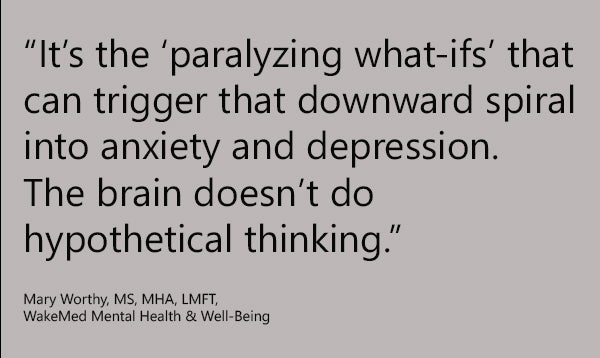Calming the What’s-Ahead Worries
December 20, 2024
Worrying about the future. We all do it from time to time. Recent significant events in our nation and world, such as a presidential election, foreign conflicts and weather disasters, have put this insomnia-inducing issues in the spotlight.
It’s natural to want to know what’s ahead. We humans are comforted by knowledge and control. So, when uncertainty enters the picture, fear of the unknown can send us down a rabbit hole of speculation and conjecture.
“It’s the ‘paralyzing what-ifs’ that can trigger that downward spiral into anxiety and depression,” explains Mary Worthy, MS, MHA, LMFT, director, WakeMed Mental Health & Well-Being. “The brain doesn’t do ‘hypothetical thinking’. It responds to what it believes is happening. So, if you speculate that something you are uncertain about is going to lead to, say, a house fire, your brain believes the house fire will happen. This can trigger your fight or flight response and all of the sudden you are in a state of heightened anxiety.”
Worthy points to the simple model developed by psychiatrist Dan Siegel, MD, to help people understand what happens in the brain when emotions get the best of our ability to reason. It’s a quick watch.
“When we are overcome with emotion — be it grief, anxiety, depression — we lose the ability to think and reason effectively — we ‘flip our lids’, according to Siegel. That’s why it’s never a good idea to make important decisions when we experience these intense surges of emotions,” explains Worthy.
Moving forward in strength
“A lot of people are not sitting in strength today,” says Worthy. “Instead, they are focusing on what will go wrong. This negative self-talk increases stress and depression and can contribute to physical health issues like insomnia and high blood pressure. We can change this. Our internal dialogue, the conversations we have with ourselves, plays a crucial role in shaping our mental and physical well-being. When we constantly tell ourselves that things will go wrong, we create a self-fulfilling prophecy that heightens our anxiety and stress levels. This negative mindset can trap us in a cycle of fear and doubt, preventing us from taking positive actions. What we tell ourselves dictates if we walk forward in strength.”
To move forward in strength means to cultivate a positive and empowering internal dialogue. It involves recognizing and challenging our negative thoughts and replacing them with affirmations of our capabilities and resilience. Walking forward in strength is about believing in our ability to handle challenges and trusting that we can navigate difficulties with grace and confidence. By doing so, we not only improve our mental health but also enhance our overall quality of life.
Worthy suggests some ways to ‘lower our lids’ and have a more positive, healthy mindset.
- What can you achieve? – Focus on the things in your life that you can control — that you can achieve. It may be those mundane things like making your bed or taking a walk every day. Worthy focuses on what is in her control and power to bring joy to people in her day-to-day life.
- Take a break from the news and social media. Worthy says it so well: “Our minds were not meant to have 24/7 access to all of the world’s problems.” Curb your news and social media exposure or take a complete hiatus from it to eliminate what may be a big stressor in your life. Note how you feel with the change and then make decisions about how/if to reintroduce it.
- Stay connected. National research supports the positive impact of human connections and our overall wellness. Being invested in others’ lives can bring a sense of belonging and joy. Spend time with those you love, volunteer for organizations your about and generally look for ways you can create human connection in our digital world.
- Be aware of your state of mind. “Take a step back and recognize when you are in an emotional, overloaded state,” suggests Worthy. “When you realize you are not thinking clearly, you can take steps to regain clarity.”
- Consider grounding/mindfulness practices. These are simple things you can do to reset your mind and return to a calm state. Bilateral tapping involves using the hands to tap one side of the body and then the other to simultaneously stimulate both sides of the brain. The butterfly hug is one very simple yet effective form of bilateral tapping to try.
- Breathing techniques are also outstanding practices to help return your mind to balance. PsychCentral.com offers five great breathing techniques you can use anywhere to reduce stress.
- You are what you eat, sleep, drink, lift, move. Refrain from unhealthy behaviors like drinking alcohol or smoking when you are stressed, and focus on exercising every day, getting quality sleep and eating right. Healthy habits will help you maintain your mental wellness in the long run.
- Seek help. When worries about what’s ahead are more than you can manage, don’t hesitate to seek guidance and support from a licensed mental health therapist/counselor. You can also call the 988 Lifeline for support and/or a referral to a local provider. If you are a WakeMed Primary Care patient, you can also access mental health providers through your primary care physician.
Wishing you a year of staying in your strength.
About WakeMed Mental Health & Well-Being
WakeMed offers psychological services to adult and pediatric patients referred by our designated Primary Care providers. Patients are identified based on our Whole Health assessment, which takes place at the start of each patient visit. These patients may be eligible for Outpatient Behavioral Health services which include Adult and Pediatric Behavioral Health as well as Virtual Behavioral Health services.
Patients typically transition to another provider within the Behavioral Health Network as time progresses and the patient is stabilized.